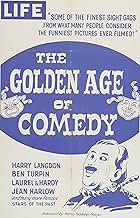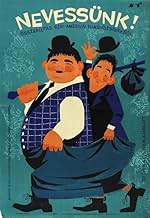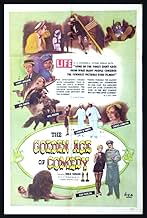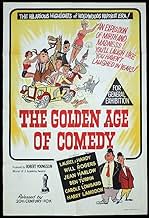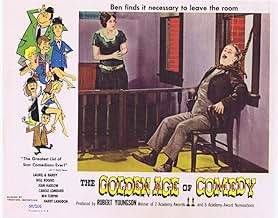A compilation of scenes featuring some of the best-known comics from the silent era in their best films.A compilation of scenes featuring some of the best-known comics from the silent era in their best films.A compilation of scenes featuring some of the best-known comics from the silent era in their best films.
Stan Laurel
- Stan
- (archive footage)
- (as Laurel)
Oliver Hardy
- Ollie
- (archive footage)
- (as Hardy)
Ben Turpin
- Rodney St. Clair
- (archive footage)
Andy Clyde
- Andy
- (archive footage)
Ward Wilson
- Self - Narrator
- (voice)
Edgar Dearing
- Policeman at Car Fight
- (archive footage)
Madalynne Field
- Fat Girl Track Competitor
- (archive footage)
- Director
- Writers
- All cast & crew
- Production, box office & more at IMDbPro
Featured review
THE GOLDEN AGE OF COMEDY was producer-director Robert Youngson's first compilation feature film consisting of clips from silent era comedy shorts. The movie was a surprise hit in 1957 and led to six more films of this nature spanning into 1970 as well as 1964's THE BIG PARADE OF COMEDY with clipped MGM feature films. This obviously isn't the best way to see silent comedies but it's very good and was a very rare chance for the general public in the 1950's and 1960's to see silent movie footage, particularly on a theater screen and certainly Youngson's films were an invaluable contribution to the burgeoning popularity of these vintage films which had begun to find their way onto the home movie market via Super 8, 8mm, and 16mm.
A number of the reviewers here have panned or given limited praise to this film because of the conspicuously missing silent era legends like Chaplin, Keaton, and Lloyd however the movie never suggests it is an definitive look at silent comedies just a "memory book" of what the era was like and the type of wild humor audiences enjoyed some thirty earlier. The clips all come from either Hal Roach or Mack Sennett films and are actually limited to 1920's films, nothing from the 1910's that I can tell. Laurel and Hardy enjoy the most footage with an extended abbreviation from TWO TARS (an interesting look at 1920's road rage which we are told is one of the acknowledged classic shorts but actually seems one of the less funny of the segments given it's fairly repetitive and predictable). I think the boys are better served by footage as ingenious prisoners who paint their way to an escape, a short but funny bit about the perils of reading street signs in the dark, or walking city streets with open manholes. There's also footage from the classic DOUBLE WHOOPEE thanks to Jean Harlow's legendary appearance in the short in her shorts.
Harry Langdon called "one of the great four comedians of the screen" (the other three are not mentioned by name but we know who they are) in a segment that is cute but underwhelming. At least it's better than the seldom funny Ben Turpin or Will Rogers' surprisingly not too successful attempts at burlesquing movie heroes from the short UNCENSORED MOVIES. Lovely teen-aged Carole Lombard is shown in footage from RUN GIRL RUN where most of the comic gags are played by pint-sized coach Daphne Pollard or fat girl Madelyne Field. One of my favorite comedians, Charley Chase is seen in an amusing segment with a brat kid and a circus lion.
Surprisingly much of the funniest footage comes from unheralded (and often uncredited here) comics in various early bits as well as a checkers-playing cat and poker-cheating dog. There is an extended quite funny pie fight riot as well as pants-pulling, knee-kicking street war led by Laurel and Hardy as well as such stock silent comedy staples as the horse-driven fire engines, train tunnels, criminals on the loose on a train, houses falling apart like paper, et al. Do try to see these comics in unedited form in their original films but if you get a chance don't miss checking out Youngson's historic films that introduced silent comedy to a whole new audience a half-century ago.
A number of the reviewers here have panned or given limited praise to this film because of the conspicuously missing silent era legends like Chaplin, Keaton, and Lloyd however the movie never suggests it is an definitive look at silent comedies just a "memory book" of what the era was like and the type of wild humor audiences enjoyed some thirty earlier. The clips all come from either Hal Roach or Mack Sennett films and are actually limited to 1920's films, nothing from the 1910's that I can tell. Laurel and Hardy enjoy the most footage with an extended abbreviation from TWO TARS (an interesting look at 1920's road rage which we are told is one of the acknowledged classic shorts but actually seems one of the less funny of the segments given it's fairly repetitive and predictable). I think the boys are better served by footage as ingenious prisoners who paint their way to an escape, a short but funny bit about the perils of reading street signs in the dark, or walking city streets with open manholes. There's also footage from the classic DOUBLE WHOOPEE thanks to Jean Harlow's legendary appearance in the short in her shorts.
Harry Langdon called "one of the great four comedians of the screen" (the other three are not mentioned by name but we know who they are) in a segment that is cute but underwhelming. At least it's better than the seldom funny Ben Turpin or Will Rogers' surprisingly not too successful attempts at burlesquing movie heroes from the short UNCENSORED MOVIES. Lovely teen-aged Carole Lombard is shown in footage from RUN GIRL RUN where most of the comic gags are played by pint-sized coach Daphne Pollard or fat girl Madelyne Field. One of my favorite comedians, Charley Chase is seen in an amusing segment with a brat kid and a circus lion.
Surprisingly much of the funniest footage comes from unheralded (and often uncredited here) comics in various early bits as well as a checkers-playing cat and poker-cheating dog. There is an extended quite funny pie fight riot as well as pants-pulling, knee-kicking street war led by Laurel and Hardy as well as such stock silent comedy staples as the horse-driven fire engines, train tunnels, criminals on the loose on a train, houses falling apart like paper, et al. Do try to see these comics in unedited form in their original films but if you get a chance don't miss checking out Youngson's historic films that introduced silent comedy to a whole new audience a half-century ago.
Storyline
Did you know
- GoofsThe narrator cites a clip of Laurel and Hardy as coming from "We Slip Up." Laurel and Hardy never made a movie with that title. The actual movie referenced is We Faw Down (1928).
- Alternate versionsThere is an Italian edition of this film on DVD, distributed by DNA Srl: "CAVALCATA DELLA RISATA (1957) + LA BOMBA COMICA (Ça c'est du cinéma, 1951)" (2 Films on a single DVD, with "Ça c'est du cinéma" in double version, with alternative cut titled "I terribili antenati di James Bond"), re-edited with the contribution of film historian Riccardo Cusin. This version is also available for streaming on some platforms.
- ConnectionsEdited from The Dare-Devil (1923)
Details
- Release date
- Country of origin
- Language
- Also known as
- The First Kings of Comedy
- See more company credits at IMDbPro
- Runtime1 hour 19 minutes
- Color
- Sound mix
- Aspect ratio
- 1.33 : 1
Contribute to this page
Suggest an edit or add missing content

Top Gap
By what name was The Golden Age of Comedy (1957) officially released in Canada in English?
Answer

















